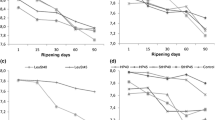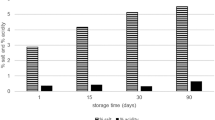Summary
Kashkaval cheese is produced with a traditional yogurt starter culture S. thermophilus 13a + Lb. delbrueckii ssp. bulgaricus 2–11. The present paper has investigated the contribution of a selected starter culture (Lactococcus lactis ssp. lactis C11 + Streptococcus thermophilus P23 + Lactobacillus casei ssp. casei RP5) for proteolysis of Kashkaval (A) in comparison with a traditional yogurt culture (B) and soluble nitrogen (at pH 4.6 and in 12% TCA) and free amino acids as indicators of Kashkaval ripeness. After the microflora was isolated and differentiated, the largest count of mesophilic cocci (69%) and lower counts of thermophilic cocci (19.8%) and mesophilic lactobacilli (11.2%) were found in cheddared curd A, whereas in cheddared curd B thermophilic cocci (69%) prevailed over thermophilic lactobacilli (30%). Hot-brining of curd at 72 °C for 2 min destroyed 91 and 84.5%, respectively, of the starter microflora A and B and two batches of Kashkaval started ripening with 3.9 × 108 c.f.u. g−1 and 3.4 × 108 c.f.u. g−1. The ripening of Kashkaval cheese occurred mainly under the influence of the starter microflora. Ripening of Kashkaval A occurred with dominating presence of Lactobacillus casei ssp. casei RP5 from 64% at day 30 to 95.2% at day 90. In Kashkaval B the participation of Lactobacillus delbrueckii ssp. bulgaricus 2–11 increased from 36.3 to 39.9%, however it always remained relatively smaller (1.5–2.3-fold) than that of thermophilic cocci. Great activity of transformation of pH 4.6-soluble nitrogen into TCA-soluble nitrogen in Kashkaval A was registered. The high proteolytic activity of starter culture A shortened the ripening process by 30 days (30-day-old Kashkaval A had 17.3% level of proteolysis, 29.9% depth of proteolysis). Kashkaval B reached satisfactory ripeness properties when it was 60 days old (20.2% level of proteolysis, 24.9% depth of proteolysis). The high activity of amino acid release mainly by Lactobacillus casei ssp. casei RP5 and to a lesser extent by the cocci caused accumulation of a considerable amount of free amino acids in ripe Kashkaval A (421.9 mg (100 g)−1 for 30-day-old Kashkaval). In ripe 30-day-old Kashkaval A the concentration of free amino acids was three times higher than in Kashkaval B, with domination of lysine, leucine, phenylalanine, valine and threonine.
Similar content being viewed by others
References
Arora, G. & Lee, B.H. 1992 Purification and characterization of aminopeptidase from Lactobacillus casei ssp. casei LLG. Journal of Dairy Science 75, 700–710
Barbano D.M., Clark J.L., Dunham C.E., Fleming J.R., 1990 Kjeldahl method for determination of total nitrogen content in milk: collaborative study Journal of the Association of Official Analytical Chemists 73: 849–854
Barbano, D.M., Chu, K.Y., Yun, J.J. & Kindstedt, P.S. 1993 Contributions of coagulant, starter culture, and milk enzymes to proteolysis and browning in Mozzarella cheese. In Proceedings of 31th Annual Marschall Italian Cheese Seminar, Rhone-Poulenc, Madison, WI, pp. 65–79
Barbano, D.M., Hong, Y., Yun, J.J., Larose, K.L. & Kindstedt, P.S. 1995 Mozzarella cheese: impact of three commercial culture strains on composition, yield, proteolysis, and functional properties. In Proceedings of 33rd Annual of Marshall Italian Cheese Seminar, Rhone-Poulenc, Madison, WI, pp. 42–55
Beshkova D.M., Simova E.D., Frengova G.I., Simov Zh.I., Adilov E.F., 1998 Production of amino acids by yogurt bacteria Biotechnology Progress 14: 963–965
Caric, M. 1993 Ripened cheese varieties native to the Balkan countries. In Cheese: Chemistry, Physics and Microbiology, ed. Fox P.F. Vol. 2, Chapter 9, pp. 263–279. London: Chapman & Hall. ISBN 0412582309
Chavagnat F., Casey M.G., Meyer J., 1999 Purification, characterization, gene cloning, sequencing, and overexpression of aminopeptidase N from Streptococcus thermophilus A Applied and Environmental Microbiology 65: 3001–3007
Choisy, C., Desmazeaud, M., Gripon, J.-C., Lamberet, G. & Lanoir, J. 1997 La biochimie de l’affinage. In Le fromage. De la science à l’assurance-qualité, 3th edn, eds. Eck A. & Gillis J.-C., pp. 86–121. Londres, New York: Tec & Doc, Lavoisier. ISBN 2–7430–0150-X
Christensen S., Weiegers T., Hermansen J., Sottrup-Jensen L., 1995 Plasma-derived protease inhibitors in bovine milk International Dairy Journal 5: 439–449
Christensen J.E., Dudley E.G., Pederson J.A., Steele J.L., 1999 Peptidases and amino acid catabolism in lactic acid bacteria Antonie van Leeuwenhoek 76: 217–246
De Man J.C., Rogosa M., Sharpe M.E., 1960 A medium for the cultivation of lactobacilli Applied Bacteriology 23: 130–135
El Soda M., Madkor S.A., Tong P.S., 2000 Adjunct cultures: recent development and potential significance to the cheese industry Journal of Dairy Science 83: 609–619
Feeney E.P., Fox P.F., Guinee T.P., 2001 Effect of ripening temperature on the quality of a low moisture Mozzarella cheese: 1. Composition and proteolysis Lait 81: 463–467
Fira D., Kojic M., Banina A., Spasojevic I., Strahinic I., Topisirovic I., 2001 Characterization of cell envelope-associated proteinase of thermophilic lactobacilli Journal of Applied Microbioliology 90: 123–130
Fizsimons N.A., Cogan T.M., Condon S., Beresford T., 1999 Phenotypic and genotypic characterization of non-starter lactic acid bacteria in mature Cheddar cheese Applied and Environmental Microbiology 65: 3418–3426
Fox P.F., 1989 Proteolysis during cheese manufacture and ripening Journal of Dairy Science 72: 1379–1400
Fox, P.F., Law, J., McSweeney, P.L.H. & Wallace, J. 1993 Biochemistry of cheese ripening. In Cheese: Chemistry, Physics and Microbiology, ed. Fox P.F., pp. 389–438. London: Chapman & Hall. ISBN 0412582309
Fox, P.F. 1998 Developments in biochemistry of cheese ripening. 25th International Dairy Congress, Aarhus, Denmark, Sept. 21–24, 1998. Progress of Dairy Science and Technology pp. 11–37
Gao S., Oh D.H., Broadbent J.R., Johnson M.E., Weiner B.C., Steele J.L., 1997 Aromatic amino acid catabolism by lactococci Lait 77: 371–381
Griffith R., Hammond E.G., 1989 Generation of Swiss cheese flavor components by the reaction of amoni acids with carbonyl compounds Journal of Dairy Science 72: 604–612
Hynes E., Bach C., Lamberet G., Ogier J.-C., Son O., Delacroix-Buchet A., 2003 Contribution of starter lactococci and adjunct lactobacilli to proteolysis, volatile profile and sensory characteristics of washed-curd cheese Lait 83: 31–43
IDF Standard 20 B. 1993 Determination of Nitrogen: Titrimetric, Kjeldahl, Block Digester. (Cheese and Processed Cheese). Brussels, Belgium: International Dairy Federation
Innocente N., 1997 Free amino acids and water-soluble nitrogen as ripening indices in Montasio cheese Lait 77: 359–369
Juillard V., Laan H., Kunji E.R.S., Jeronimus-Stratingh C.M., Bruins A.P., Konings W.L., 1995 The extracellular PI type proteinase of Lactococcus lactis hydrolyzed β-casein into more than one hundred different oligopeptides Journal of Bacteriology 177: 3472–3478
Kandler, O. & Weiss, N. 1986 Regular, nonsporing Gram-positive rods. In Bergey’s Manual of Systematic Bacteriology, eds. Sneath P., Mair N., Sharpe M. & Holt J., Vol. 2., Section 14, pp. 1208–1234. Williams & Wilkins: Baltimore,Hong Kong, London, Sydney. ISBN 0683078933
Khalid N.M., El Soda M., Marth E.H., 1991 Peptide hydrolases of Lactobacillus helveticus and Lactobacillus delbrueckii ssp. bulgaricus Journal of Dairy Science 74: 29–45
Kieronczyk A., Skeie S., Langsrud T., Yvon M., 2003 Cooperation between Lactococcus lactis and nonstarter lactobacilli in the formation of cheese aroma from amino acids Applied and Environmental Microbiology 69: 734–739
Kindstedt P.S., Guo M.R., 1997 Recent developments in the science and technology of pizza cheese. Review Australian Journal of Dairy Technology 52: 42–45
Kоjev А., 2002 Kаshkaval In Kojev A. (eds)Hot-Brined Cheese. Association of milk-producers in Bulgaria. Sofia 177 pp
Lynch C.M., McSweeney P.L.H., Fox P.F., Cogan T.M., Driman F.D., 1997 Contribution of starter lactococci and non-starter lactobacilli to proteolysis in Cheddar cheese with a controlled microflora Lait 77: 441–449
Lynch C.M., Muir D.D., Banks J.M., McSweeney P.L.H., Fox P.F., 1999 Influence of adjunct cultures of Lactobacillus paracasei ssp. paracasei or Lactobacillus plantarun on Cheddar cheese ripening Journal of Dairy Science 82: 1618–1628
Madsen J.S., Qvits K.B., 1998 The effect of added proteolytic enzymes on meltability of Mozzarella cheese manufactured by ultrafiltration Lait 78: 259–272
Mahaut M., Jeantet R., Brulé G., 2000 Initiation à la technologie fromagière Technique & Documentation, londres, Paris, New York pp. 123–131 ISBN 2-7430-0408-8
McSweeney P.L.H., Fox P.F., Lucey J.A., Jordan K.N., Cogan T.M., 1993 Contribution of the indigenous microflora of the maturation of Cheddar cheese International Dairy Journal 3: 613–634
Neocleous M., Barbano D.M., Rudan M.A., 2002 Impact of low concentration factor microfiltration on the composition and aging of Cheddar cheese Journal of Dairy Science 85: 2425–2437
Pellegrino L., Hogenboom J.A., Pazzaglia C., Tedesco R., 1995 Caratterizzazione analitica del formaggio Fontina sulla base della sua composizione in amminoacidi liberi Latte 10: 1086–1093
Politis I., Barbano D.M., Gorewit R.C., 1992 Distribution of plasminogen and plasmib in fractions of bovine milk Journal of Dairy Science 75: 1402–1410
Resmini P., Hogenboom J.A., Pazzaglia C., Pellegrino L., 1993 Gli amminoacidi liberi nella caratterizzazione analitica del formaggio Grana Padano Sciencia Tecnologica Latte-Casearia 36: 557–592
Rijnen L., Courtin P., Gripon J.C., Yvon M., 2000 Expression of a heterologous glutamate dehydrogenase gene in Lactococcus lactis highly improves the conversion of amino acids to aroma compounds Applied and Environmental Microbiology 66: 1354–1359
Rul, F., Gripon, J.-C. & Monnet, V. 1995 St-PepA, a Streptococcus thermophilus aminopeptidase with high specificity for acidic residues. Microbiology 141, 2281–2287
Sasaki M., Bosman B.W., Tan P.S.T., 1995 Comparison of proteolytic activities in various lactobacilli Journal of Dairy Research 62: 601–610
Schleifer, K. 1986 Gram-positive cocci. In Bergey’s Manual of Systematic Bacteriology, eds. Sneath P., Mair N., Sharpe M. & Holt J., Vol. 2., Section 12, pp. 1043–1071. Williams & Wilkins: Baltimore, Hong Kong, London, Sydney. ISBN 0683078933
Shakeel-Ur-Rehman, Banks J.M., McSweeney P.L.H., Fox P.F., 2000 Effect of ripening temperature on the growth and significance of non-starter acid bacteria in Cheddar cheese made from raw or pasteurized milk International Dairy Journal 10: 45–53
Shihata A., Shah N.P., 2000 Proteolytic profiles of yogurt and probiotic bacteria International Dairy Journal 10: 401–408
Somers J.M., Kelly A.L., 2002 Contribution of plasmin to primary proteolysis during ripening of cheese: effect of milk heat treatment and cheese cooking temperature Lait 82: 181–191
Tan P.S.T., Poolman B., Konings W.N., 1993 Proteolytic enzymes of Lactococcus lactis Journal of Dairy Research 60: 269–286
Terazagni B.E., Sandine W.E., 1975 Improved medium for lactic streptococci and their bacteriophages Applied Microbiology 29: 807–813
Tsakalidou E., Dalezios I., Georgalaki M., Kalantzopoulos G., 1993 A comparative study: aminopeptidase activities from Lactobacillus delbrueckii ssp. bulgaricus and Streptococcus thermophilus Journal of Dairy Science 76: 2145–2151
Urbach G., 1997 The flavour of milk and dairy products. 2. Cheese: contribution of volatile compoundsInternational Journal of Dairy Technology 50: 79–89
Visser F.M.W., 1977 Contribution of enzymes from rennet, starter bacteria and milk to proteolysis and flavour development in Gouda cheese. 3. Protein breakdown: analysis of the soluble nitrogen and amino acid nitrogen fractions Netherlands Milk and Dairy Journal 31: 210–219
Williams A.G., Noble J., Banks J.M., 2001 Catabolism of amino acid by lactic acid bacteria isolated from Cheddar cheese International Dairy Journal 11: 203–215
Wohlrab Y., Bockelmans W., 1992 Purification and characterization of a dipeptidase from Lactobacillus delbrueckii ssp. bulgaricus International Dairy Journal 2: 345–361
Yun J.J., Barbano D.M., Kindstedt P.S., 1993 Mozzarella cheese; impact of milling pH on chemical composition and proteolysis Journal of Dairy Science 76: 3629–3638
Yun J.J., Barbano D.M., Kiely L.J., Kindstedt P.S., 1995 Mazzarella cheese: impact of rods:coccus ratio on composition, proteolysis, and functional properties Journal of Dairy Science 78: 751–760
Yun J.J., Barbano D.M., Larose K.L., Kindstedt P.S., 1998 Mozzarella cheese: impact of non-fat dry milk fortification on composition, proteolysis, and functional properties Journal of Dairy Science 81: 1–8
Yvon M., Thirouin S., Rijnen L., Fromentier D., Gripon J.C., 1997 An aminotransferase from Lactococcus lactis initiates conversion of amino acid to cheese flavour compounds Applied and Environmental Microbiology 63: 414–419
Yvon M., Rijnen L., 2001 Cheese flavour formation by amino acid catabolism International Dairy Journal 11: 185–201
Author information
Authors and Affiliations
Corresponding author
Rights and permissions
About this article
Cite this article
Simov, Z.I., Simova, E.D. & Beshkova, D.M. Impact of two starter cultures on proteolysis in Kashkaval cheese. World J Microbiol Biotechnol 22, 147–156 (2006). https://doi.org/10.1007/s11274-005-9012-5
Received:
Accepted:
Published:
Issue Date:
DOI: https://doi.org/10.1007/s11274-005-9012-5




